
Life sciences company Thermo Fisher (NYSE:TMO) reported Q3 CY2025 results topping the market’s revenue expectations, with sales up 4.9% year on year to $11.12 billion. Its non-GAAP profit of $5.79 per share was 5.3% above analysts’ consensus estimates.
Is now the time to buy Thermo Fisher? Find out by accessing our full research report, it’s free for active Edge members.
Thermo Fisher (TMO) Q3 CY2025 Highlights:
- Revenue: $11.12 billion vs analyst estimates of $10.92 billion (4.9% year-on-year growth, 1.9% beat)
- Adjusted EPS: $5.79 vs analyst estimates of $5.50 (5.3% beat)
- Adjusted EBITDA: $2.60 billion vs analyst estimates of $2.70 billion (23.4% margin, 3.7% miss)
- Operating Margin: 17.5%, in line with the same quarter last year
- Free Cash Flow Margin: 16.5%, down from 17.9% in the same quarter last year
- Organic Revenue rose 3% year on year vs analyst estimates of 2.7% growth (31.6 basis point beat)
- Market Capitalization: $210.7 billion
“Our team did an outstanding job and delivered excellent operational performance in the quarter, reflecting the strength of our proven growth strategy, the power of our PPI Business System, and the continued active management of our company,” said Marc N. Casper, chairman, president and chief executive officer of Thermo Fisher Scientific.
Company Overview
With over 14,000 sales personnel and a portfolio spanning more than 2,500 technology manufacturers, Thermo Fisher Scientific (NYSE:TMO) provides scientific equipment, reagents, consumables, software, and laboratory services to pharmaceutical, biotech, academic, and healthcare customers worldwide.
Revenue Growth
A company’s long-term sales performance is one signal of its overall quality. Any business can put up a good quarter or two, but the best consistently grow over the long haul. Thankfully, Thermo Fisher’s 8.9% annualized revenue growth over the last five years was decent. Its growth was slightly above the average healthcare company and shows its offerings resonate with customers.
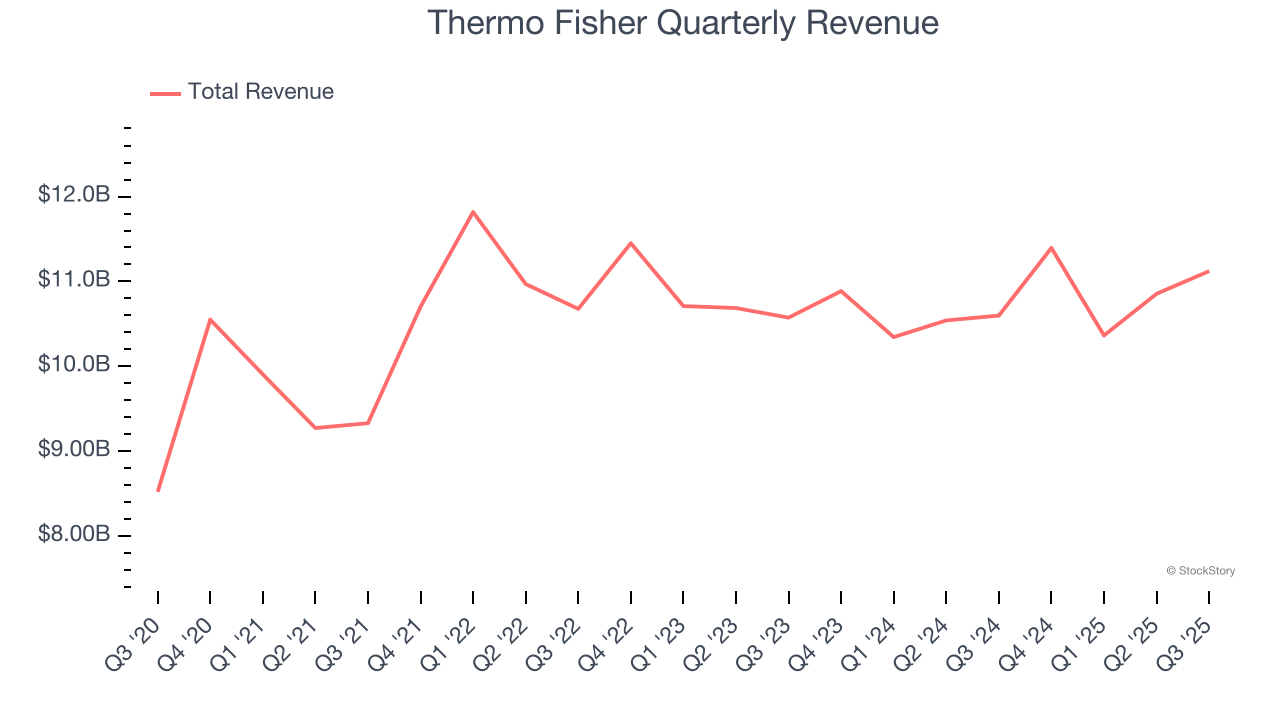
Long-term growth is the most important, but within healthcare, a half-decade historical view may miss new innovations or demand cycles. Thermo Fisher’s recent performance shows its demand has slowed as its revenue was flat over the last two years. 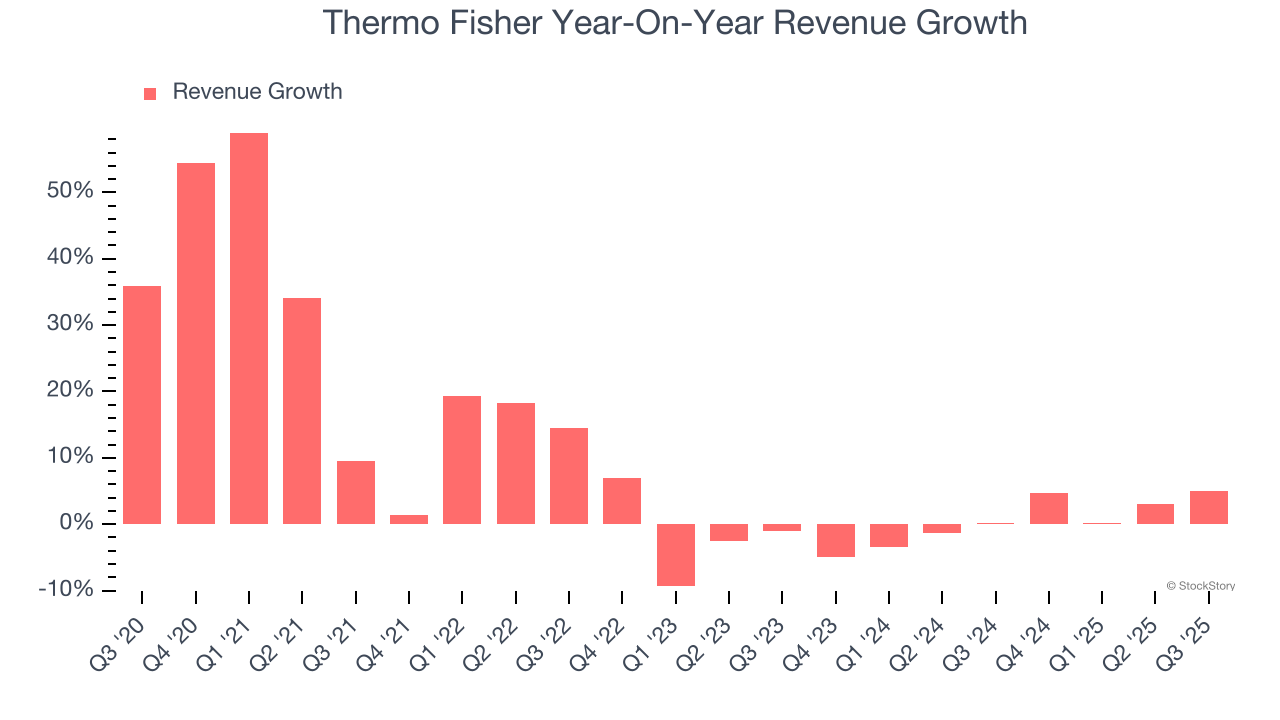
Thermo Fisher also reports organic revenue, which strips out one-time events like acquisitions and currency fluctuations that don’t accurately reflect its fundamentals. Over the last two years, Thermo Fisher’s organic revenue was flat. Because this number aligns with its two-year revenue growth, we can see the company’s core operations (not acquisitions and divestitures) drove most of its results. 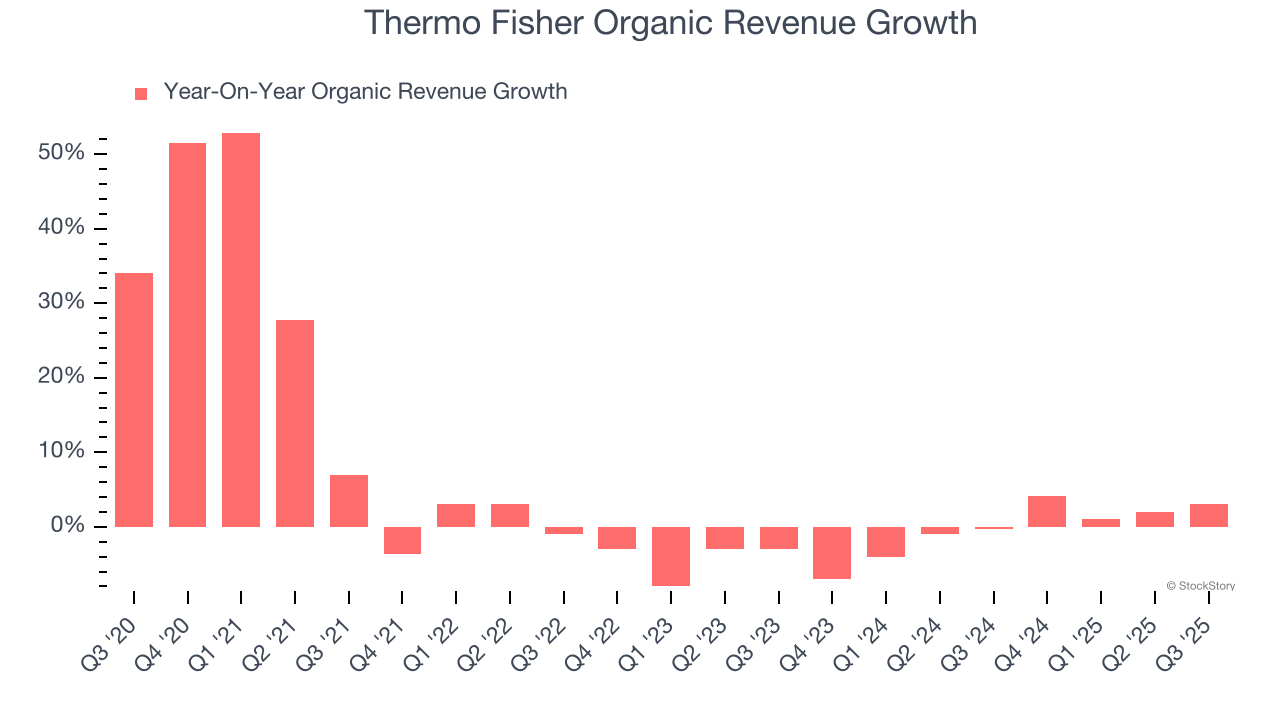
This quarter, Thermo Fisher reported modest year-on-year revenue growth of 4.9% but beat Wall Street’s estimates by 1.9%.
Looking ahead, sell-side analysts expect revenue to grow 3.9% over the next 12 months. While this projection suggests its newer products and services will spur better top-line performance, it is still below average for the sector.
Software is eating the world and there is virtually no industry left that has been untouched by it. That drives increasing demand for tools helping software developers do their jobs, whether it be monitoring critical cloud infrastructure, integrating audio and video functionality, or ensuring smooth content streaming. Click here to access a free report on our 3 favorite stocks to play this generational megatrend.
Operating Margin
Operating margin is an important measure of profitability as it shows the portion of revenue left after accounting for all core expenses – everything from the cost of goods sold to advertising and wages. It’s also useful for comparing profitability across companies with different levels of debt and tax rates because it excludes interest and taxes.
Thermo Fisher has managed its cost base well over the last five years. It demonstrated solid profitability for a healthcare business, producing an average operating margin of 19.4%.
Analyzing the trend in its profitability, Thermo Fisher’s operating margin decreased by 9.9 percentage points over the last five years, but it rose by 1.4 percentage points on a two-year basis. Still, shareholders will want to see Thermo Fisher become more profitable in the future.
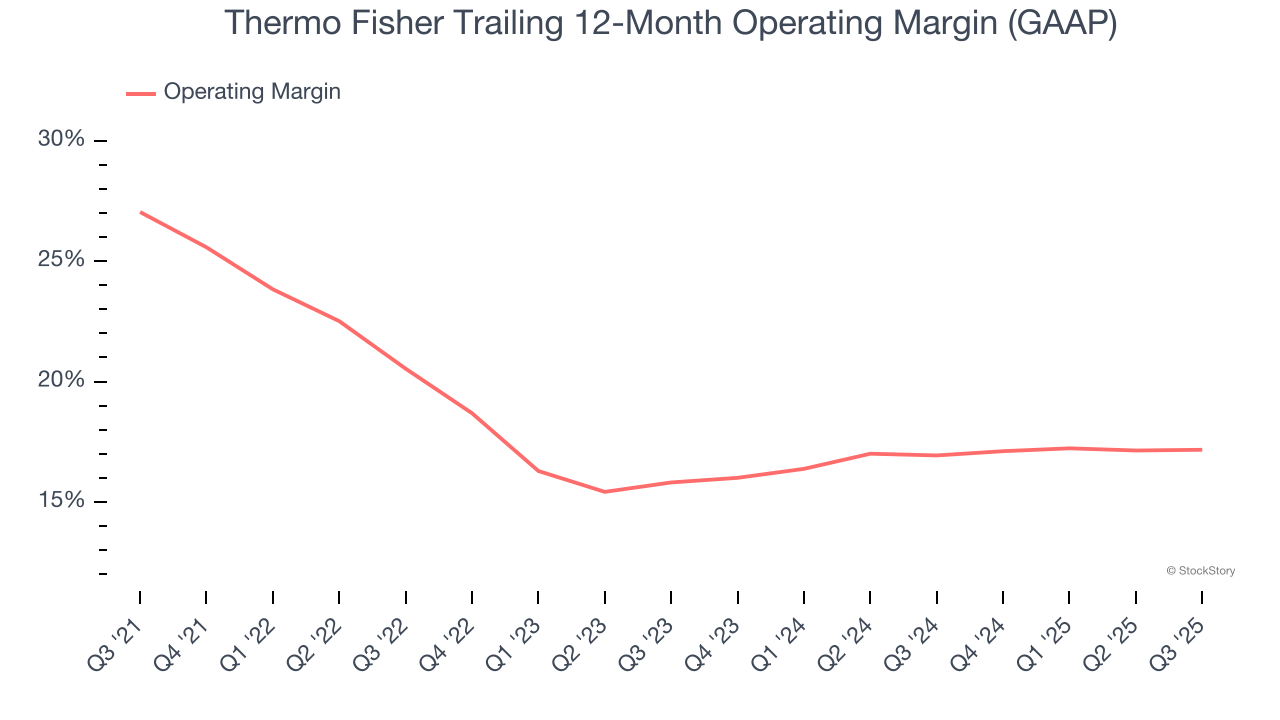
In Q3, Thermo Fisher generated an operating margin profit margin of 17.5%, in line with the same quarter last year. This indicates the company’s overall cost structure has been relatively stable.
Earnings Per Share
We track the long-term change in earnings per share (EPS) for the same reason as long-term revenue growth. Compared to revenue, however, EPS highlights whether a company’s growth is profitable.
Thermo Fisher’s EPS grew at a decent 6.9% compounded annual growth rate over the last five years. However, this performance was lower than its 8.9% annualized revenue growth, telling us the company became less profitable on a per-share basis as it expanded due to non-fundamental factors such as interest expenses and taxes.
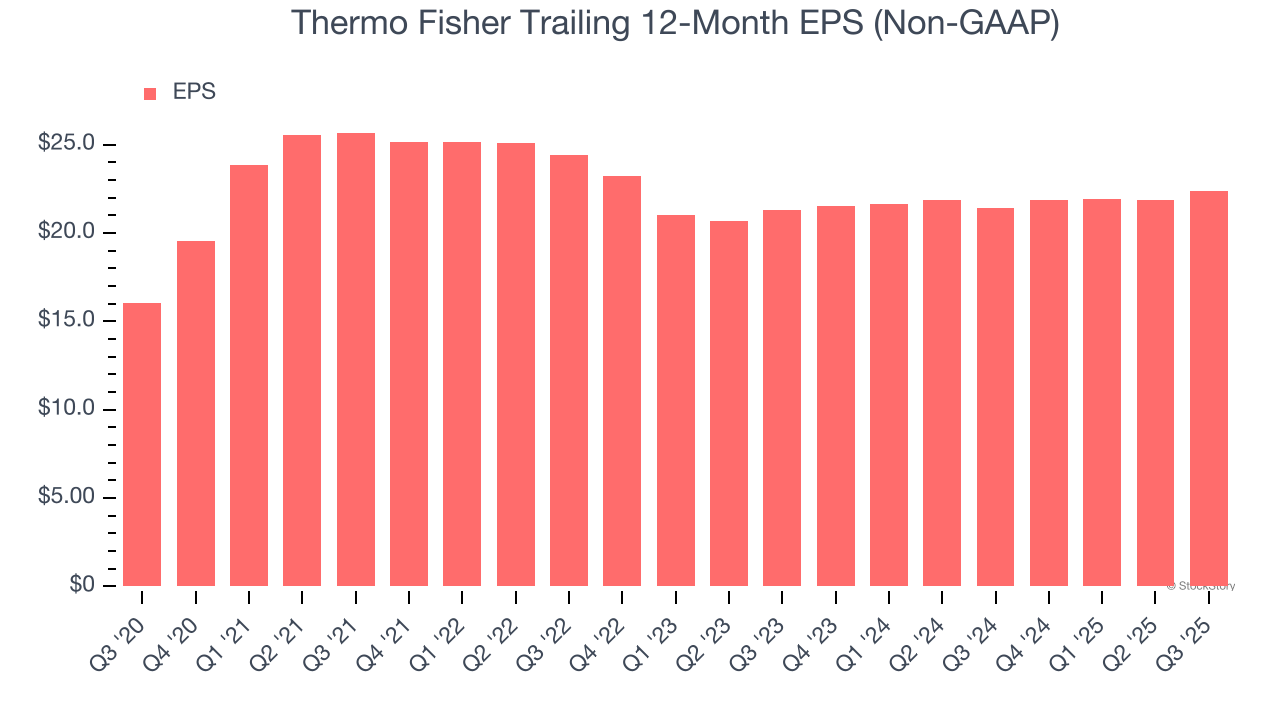
Diving into Thermo Fisher’s quality of earnings can give us a better understanding of its performance. As we mentioned earlier, Thermo Fisher’s operating margin was flat this quarter but declined by 9.9 percentage points over the last five years. This was the most relevant factor (aside from the revenue impact) behind its lower earnings; interest expenses and taxes can also affect EPS but don’t tell us as much about a company’s fundamentals.
In Q3, Thermo Fisher reported adjusted EPS of $5.79, up from $5.28 in the same quarter last year. This print beat analysts’ estimates by 5.3%. Over the next 12 months, Wall Street expects Thermo Fisher’s full-year EPS of $22.40 to grow 7%.
Key Takeaways from Thermo Fisher’s Q3 Results
It was encouraging to see Thermo Fisher beat analysts’ revenue expectations this quarter. We were also glad its EPS outperformed Wall Street’s estimates. Overall, this print had some key positives. The stock traded up 3.1% to $575 immediately following the results.
Thermo Fisher put up rock-solid earnings, but one quarter doesn’t necessarily make the stock a buy. Let’s see if this is a good investment. What happened in the latest quarter matters, but not as much as longer-term business quality and valuation, when deciding whether to invest in this stock. We cover that in our actionable full research report which you can read here, it’s free for active Edge members.
